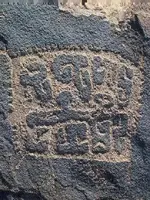cactusjumper
Gold Member
Re: CPTBIL's mention of Aztec pictographs in SE Arizona
Roy,
Sorry, I missed your reply here.
I don't really disagree with your opinions, as there is evidence to support whatever position anyone wishes to take.
My own opinion is that the Asian occupation of Alaska was a direct results of their following the mammoths, and other primary food sources across the Bering Land Bridge. As there was pressure from the Asian hunters, the animal population would have retreated away from them, and eastward across Beringia.
The wind being unpredictable in the straits, it's hard to say with certainty that the animals were following there noses towards the lush interior of Alaska. At the times when the wind would blow in a westerly direction, there seems little doubt that they could fail to notice which direction promised sustenance.
While there is some argument against it, the evidence seems to support a verdant plain with more than sufficient grass' to support the animals as they moved east across the land bridge.
"Lets look at this from the other direction - where is there any evidence of Clovis having developed in east Asia? Solutrean tools and points are so close to Clovis that often it takes an expert to differentiate them. No expertise is required to differentiate between Clovis and Siberian cultural artifacts, the technology is quite different. The Siberian micro-blade technology dates back over 20,000 years, so...we ought to find microblade tools in a regular trail from the land bridge to Tierra del Fuego, but we don't."
The fact that Clovis like points have been found on the Kamchatka Peninsula as well as similar tools in the Nenana River Valley, both dating to the relatively same time period, denotes a more than possible connection between the two continents. It seems a good bet that Clovis like technology was being developed in Kamchatka at the time the crossings were taking place. Perhaps it was not the dominate method of producing projectile points and other tools, but was only being done by a few knappers of that era.
Compared to societies, technologies can move from place to place at the speed of a single hardy explorer. It may be picked up quickly by some of the people he comes in contact with, and totally ignored by others. That could explain some of the problems with establishing an Asian or Bering Strait/Alaskan origin for Clovis points.
In truth, there are many pros and cons to the lithics questions. The weight of other evidence however, points towards an Asian origin for all Native Americans. Each and every one of the methods for making that determination has its detractors. Others will swear by the science that is used.
No doubt you and I will solve this puzzle before the week is out.
Take care,
Joe
Roy,
Sorry, I missed your reply here.
I don't really disagree with your opinions, as there is evidence to support whatever position anyone wishes to take.
My own opinion is that the Asian occupation of Alaska was a direct results of their following the mammoths, and other primary food sources across the Bering Land Bridge. As there was pressure from the Asian hunters, the animal population would have retreated away from them, and eastward across Beringia.
The wind being unpredictable in the straits, it's hard to say with certainty that the animals were following there noses towards the lush interior of Alaska. At the times when the wind would blow in a westerly direction, there seems little doubt that they could fail to notice which direction promised sustenance.
While there is some argument against it, the evidence seems to support a verdant plain with more than sufficient grass' to support the animals as they moved east across the land bridge.
"Lets look at this from the other direction - where is there any evidence of Clovis having developed in east Asia? Solutrean tools and points are so close to Clovis that often it takes an expert to differentiate them. No expertise is required to differentiate between Clovis and Siberian cultural artifacts, the technology is quite different. The Siberian micro-blade technology dates back over 20,000 years, so...we ought to find microblade tools in a regular trail from the land bridge to Tierra del Fuego, but we don't."
The fact that Clovis like points have been found on the Kamchatka Peninsula as well as similar tools in the Nenana River Valley, both dating to the relatively same time period, denotes a more than possible connection between the two continents. It seems a good bet that Clovis like technology was being developed in Kamchatka at the time the crossings were taking place. Perhaps it was not the dominate method of producing projectile points and other tools, but was only being done by a few knappers of that era.
Compared to societies, technologies can move from place to place at the speed of a single hardy explorer. It may be picked up quickly by some of the people he comes in contact with, and totally ignored by others. That could explain some of the problems with establishing an Asian or Bering Strait/Alaskan origin for Clovis points.
In truth, there are many pros and cons to the lithics questions. The weight of other evidence however, points towards an Asian origin for all Native Americans. Each and every one of the methods for making that determination has its detractors. Others will swear by the science that is used.
No doubt you and I will solve this puzzle before the week is out.
Take care,
Joe














